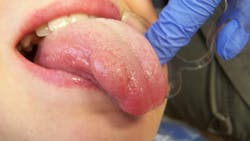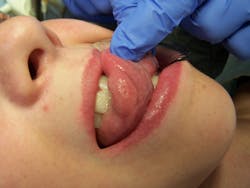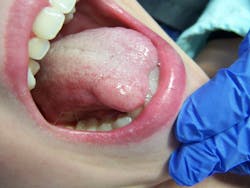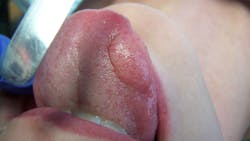Editor’s note: Originally published September 2015. Updated April 2023.
Case presentation
A 13-year-old female presents to the office for an initial exam. It had been a few years since she had seen a dentist. There were no complaints or concerns. Health history was noncontributory.
Clinical exam
Her clinical evaluation revealed the following:
- Extraoral exam: Within normal limits
- Intraoral exam: A large, 1.5 cm raised lesion was noted on the right dorsal and lateral aspects of the tongue, extending to the underside. It was normal in color, slightly firmer than the surrounding area. It was not tender to palpation and inflammation was not present. Due to the size of the lesion, there was tenderness upon mastication and normal oral functions.
When asked about its presence, the parent stated that it had been there for eight years. Apparently, the patient had fallen when she was 5 years old and had bitten her tongue. Medical treatment or advice concerning the lesion was not pursued.
The parents refused a biopsy or treatment of the area during examination.
One year later
A year later, the patient came in because of a toothache, and it was noted that the lesion had not changed in size during that period of time.
Diagnosis and recommended treatment
When this female was 5, she fell off a chair and severely bit her tongue. No treatment was sought after. This lesion developed after this trauma but has not changed in several years per the patient and her mother. The parents have been given multiple referrals for biopsy to rule out serious possibilities, but they have refused to follow through. The lesion has not changed since first noted and followed in the dental clinic for two years.
Given the history and clinical findings of this lesion, a differential diagnosis would be:
- neurofibroma
- mucosal neuromatosis
- traumatic neuroma
The clinical diagnosis is traumatic neuroma, also known as amputation neuroma or pseudoneuroma. This lesion results from a traumatic event to a nerve, such as severage. There is most often a history of laceration, surgery, or trauma. Most common locations are on the tongue, lip, or near the mental foramen.
These lesions are often painful, so surgical excision is recommended. A histopathologic examination is needed for complete diagnosis. In the case of the 13-year-old female, no biopsy has been performed due to the parents’ refusal. Although biopsy and simple surgical excision is the treatment of choice, due to lack of any pain and change of the lesion, the girl’s parents refuse any further investigation and treatment. A serious discussion took place again mid-August 2015 and another referral for biopsy and treatment was given. No attempt has been made by the parents to follow through.
More pathology cases ...
About the Author

Conway Jensen, DDS
Conway Jensen, DDS, has a bachelor’s degree in biology from Oregon State University and a dental degree from Marquette University School of Dentistry. He completed his pediatric dental training at the Children’s Hospital of Wisconsin. Dr. Jensen is a board-certified pediatric dentist in private practice in Washington state. He is active in the American Academy of Pediatric Dentistry and is a children’s dentist diplomate of the American Board of Pediatric Dentistry.



